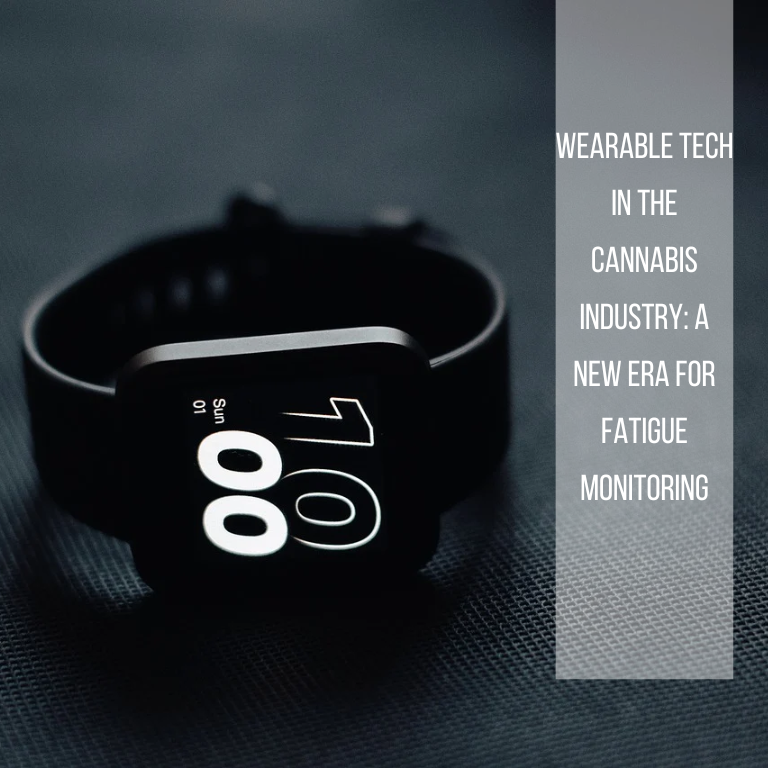Wearable Tech in the Cannabis Industry: A New Era for Fatigue Monitoring

The cannabis industry has experienced tremendous growth in recent years, driving innovation and bringing technology to the forefront of industry practices. One promising development is the integration of wearable technology for monitoring worker health, particularly fatigue levels. With legalization expanding and demand increasing, safety and productivity in cannabis operations—both in cultivation and processing—are priorities. Wearable tech that tracks fatigue provides a proactive way to safeguard employees and optimize performance, marking a significant shift towards modernized workplace wellness practices in this industry.
This article explores how wearable technology is revolutionizing the cannabis industry through fatigue monitoring, its impact on employee safety, and the future possibilities for this tech in cannabis workplaces.
The Rise of Wearable Technology for Workplace Health Monitoring
Wearable technology, encompassing devices like smartwatches, biometric sensors, and fitness bands, has increasingly entered diverse industries to track health metrics. For cannabis operations, this technology is particularly useful due to the industry’s unique set of demands, including long working hours, physically intensive tasks, and strict regulatory compliance.
Fatigue as a Workplace Hazard
Fatigue in the workplace is a significant issue across industries, but it can be particularly problematic in the cannabis sector. Workers engaged in cultivation, processing, or lab testing face long hours, often performing repetitive tasks in environments that can be physically demanding. The potential consequences of fatigue range from reduced productivity and error rates to more severe outcomes like injury due to accidents. Wearable technology designed to detect and monitor fatigue can help mitigate these risks by alerting management or workers themselves when rest is needed.
Wearables in Action: Devices like the WHOOP wristband or Garmin smartwatches, which monitor heart rate variability, sleep patterns, and physical strain, are gaining popularity. By analyzing metrics like heart rate and activity levels, these devices can estimate fatigue and notify users when they need to rest or adjust their activities.
How Wearable Tech Tracks Fatigue in Cannabis Workers
Fatigue tracking technology in wearables works by assessing a mix of biometric and behavioral data. Many wearables utilize sensors to measure physiological signals that correlate with tiredness or mental exhaustion, including:
Heart Rate Variability (HRV)
Heart rate variability is an important metric in fatigue assessment. Lower HRV can indicate higher fatigue levels, as it often corresponds with physical or mental strain. Wearables tracking HRV provide cannabis workers with real-time information on their body’s readiness to perform.
Sleep Monitoring
Quality sleep is essential for managing fatigue, but in an industry with demanding schedules, it can be challenging. Wearables that track sleep stages (light, deep, REM) and duration offer insight into whether workers are sufficiently rested. An individual’s sleep data can help managers ensure that they’re scheduling workers in ways that promote optimal productivity.
Activity and Physical Exertion Tracking
Cannabis operations, particularly those involving cultivation or processing, often require physically intensive tasks like lifting, bending, and prolonged standing. Wearables that track movement, steps, and physical exertion can assess if a worker has reached fatigue-inducing limits, encouraging them to take breaks when needed.
Benefits of Fatigue Monitoring for Cannabis Industry Workers
Incorporating wearable technology in the cannabis industry offers several benefits that extend to both employees and employers.
Enhanced Safety and Accident Prevention
Fatigue monitoring plays a critical role in preventing accidents. Tired workers are more prone to mistakes, and in environments where machinery, chemicals, and precision are involved, even small errors can lead to severe accidents. By monitoring fatigue levels, managers can adjust workloads and schedules to reduce the risk of incidents.
Increased Productivity and Efficiency
While taking breaks may seem counterintuitive to productivity, studies show that well-rested workers are more efficient. In cannabis facilities, this can mean higher-quality output and fewer errors in the product. With fatigue-monitoring wearables, workers can pace themselves better, resulting in increased output without compromising health.
Employee Wellness and Satisfaction
As the cannabis industry grows, it faces a need to prioritize worker wellness to retain talent. Wearable technology helps signal that a company values its employees’ health. By promoting a culture that encourages taking breaks based on real-time data, companies can improve job satisfaction, which ultimately contributes to retention and reduced turnover.
Data-Driven Management Decisions
Aggregate data collected from wearables can provide management with insights into peak hours for fatigue across different shifts. This data enables more strategic decision-making, allowing companies to organize shift patterns and allocate tasks in a way that minimizes fatigue risks across the workforce.
Challenges and Considerations for Implementing Wearables in Cannabis Operations
Despite the numerous benefits, integrating wearable technology into cannabis workplaces isn’t without its challenges. A few factors companies should consider include:
Privacy Concerns
Tracking biometrics like heart rate or sleep patterns can raise privacy issues. Some employees may be uncomfortable sharing such intimate data, even with the assurance that it’s used for safety purposes. Companies need to establish transparent policies, communicate how data will be used, and obtain consent to reassure workers of their privacy.
Technology Costs
Outfitting a large workforce with wearable devices can be expensive, especially for small and medium-sized cannabis operations. However, with advances in technology and increasing availability of affordable wearables, the costs are gradually becoming more manageable.
Device Maintenance and Training
As with any technology, wearables require maintenance, charging, and occasional repairs. Furthermore, employees and managers alike may need training to interpret fatigue data effectively, adding another layer to implementation.
The Future of Wearable Tech and Fatigue Monitoring in Cannabis
With wearable tech evolving rapidly, its role in fatigue monitoring within the cannabis industry is likely to expand. New developments such as artificial intelligence (AI) and machine learning (ML) will enhance fatigue detection accuracy, making real-time analysis of workers’ physical and mental states even more precise.
Integration with AI and Predictive Analytics
AI-driven algorithms could predict periods of high fatigue risk based on workers’ previous data patterns, helping managers adjust schedules proactively. AI could also account for external factors like temperature or specific job tasks that might contribute to fatigue levels.
Enhanced User Experience and Customization
As more companies adopt wearable tech, we can expect advancements that allow workers to personalize their fatigue monitoring experience. Workers may be able to set thresholds for fatigue alerts based on their individual resilience levels, ensuring a balance between safety and personal productivity.
Industry Standards and Compliance
In the future, it’s possible that regulatory bodies may set standards for fatigue monitoring in high-risk environments, including cannabis facilities. This could create industry-wide benchmarks for employee wellness, potentially making fatigue monitoring wearables mandatory in certain roles.
Wearables and Wellness Programs
The adoption of wearables may lead to comprehensive wellness programs in the cannabis industry. With access to holistic health data (such as nutrition, hydration, and stress levels), employers could offer resources that address workers’ needs more comprehensively.
Embracing a New Era of Health and Safety in Cannabis Workplaces
The integration of wearable technology in the cannabis industry for fatigue monitoring marks an exciting progression toward modern workplace safety and health. In an industry that requires significant manual labor and attention to detail, addressing fatigue can not only prevent accidents but also improve productivity and employee satisfaction. While challenges exist, the benefits of adopting wearables for fatigue monitoring far outweigh the drawbacks, and the technology’s future promises even more enhancements in health and safety.
As the cannabis sector matures, incorporating wearable technology for fatigue monitoring could become a cornerstone of its commitment to worker well-being. This proactive approach benefits the business, enhances product quality, and underscores the importance of employee health in achieving sustainable growth.











